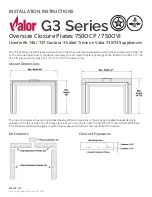
Appendix A Caching Solutions and Performance
121
✔
Information on how the ARM changes packet addresses. See ARM
redirection‚ on page 125.
✔
A description of the appliance’s adaptive bypass scheme. See Appliance
adaptive bypass‚ on page 126.
Serving requests transparently
Here’s how the Intel NetStructure Cache Appliance transparent interception
works:
Step 1
The appliance intercepts client requests to origin servers. Several appliance
deployment methods exist so that interception can take place. See Interception
strategies‚ on page 121 for details.
Step 2
The Adaptive Redirection Module (ARM) redirects requests destined for origin
servers to the appliance application. See ARM redirection‚ on page 125 for
details.
Step 3
A very small number of clients and servers do not work correctly through
proxies. The appliance identifies these problem clients and servers dynamically,
and the ARM adaptively disables interception for these clients and servers,
passing their traffic unimpeded to the original server. Also, clients and servers
can be manually exempted from caching by configuring the ARM. See Adaptive
interception bypass‚ on page 126 for more information.
Step 4
The appliance receives and begins processing the intercepted client requests as
usual. If a request is a cache hit, the appliance serves the requested document or
news article. If a request is a miss, the appliance retrieves the document from the
origin server and serves it to the client.
Step 5
On the way back to the client, the ARM changes the source IP address to the
origin server IP address and the source port to the origin server port.
Interception strategies
The transparency routing solutions supported by the Intel NetStructure Cache
Appliance are:
✔
Layer 4-aware switch. See Using a layer 4-aware switch to filter
transparency requests‚ on page 122.
✔
Cisco IOS-based router using the Web Cache Control Protocol (WCCP). See
Using a WCCP-enabled router for transparency‚ on page 123.
✔
Policy-based routing. See Using policy-based routing to filter transparency
requests‚ on page 124.
How client request traffic reaches the appliance depends on network topology. In
a complex network, you must decide which clients are to be served transparently
and make sure that the appliance is positioned to intercept their requests. The
















































